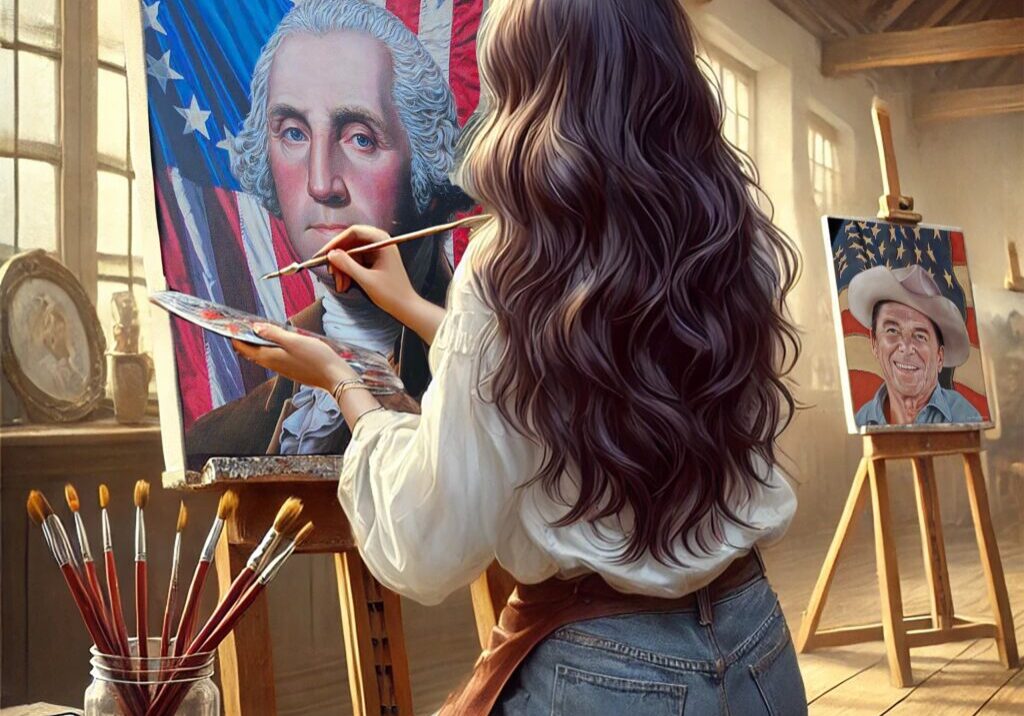
Shapes of Meaning: Arches, Lines, and Visual Anchors in the 250th Mural
As a muralist, one of the most important tools I work with isn’t the brush – it’s the structure beneath the brushwork. When painting a work as large and layered as the 250th Anniversary Mural, visual shapes become the architecture of meaning. You may not always notice them at first glance, but they’re there – quietly guiding the eye, connecting ideas, and creating emotional rhythm. Arches, circles, diagonals, and invisible lines are some of my most trusted compositional companions.
Let’s start with arches. They appear across the mural, not just as architectural elements, but as bridges between sections. A literal stone arch in the Unity section echoes forward into the semi- circle of clasped hands in Progress. These are not decorative coincidences. The arch, to me, represents continuity – something spanning across difference. It’s a form that holds weight and invites passage. Arches suggest both strength and transition, which is why I use them to frame key moments.
They carry the eye upward, then release it toward what’s next. Circles are more subtle, but just as powerful. I don’t always paint them outright – instead, I suggest them. The curve of a woman’s arm around a child. The rounded shadow of a wheel resting in mud. The arc of a canopy above a group of petitioners. These soft circular shapes suggest protection, unity, and memory. They draw the viewer inward. They ask the eye to rest, to return. In scenes filled with movement and change, circles give breath and calm. Lines, especially diagonals, provide the mural’s underlying momentum.
They are how I create movement without showing motion. A slanted flag, a sword held slightly off-vertical, a rooftop that angles across the background – all of these build energy. Diagonals can signal ascent, resistance, instability, or hope, depending on how they’re used. When I layer them across a scene, I’m not just arranging forms. I’m choreographing feeling. There’s also the matter of visual echoes. A horizontal line near the bottom of the mural might find its twin in a beam near the top. A column’s shadow might align perfectly with a path in a later scene.
These repeated structures help stitch the mural together. They remind us that even as the content changes, the underlying pulse remains. History doesn’t unfold randomly. It follows rhythm, pattern, resistance, and return. The visual structure mirrors that. One of my favorite uses of shape is suggestion. A triangle of figures leaning toward a shared object – a document, a candle, a child – creates focus without spotlight. A soft curve leading from a poster to a waiting hand implies movement without depicting it. These forms carry emotion.
They shape the way the viewer feels the weight of a moment before they even understand its context. All of this happens in layers. I don’t impose shapes at the start. I find them. I sketch freely, let elements fall where they want, and then begin to see what geometry is already speaking. Once I recognize a form – a gentle arc, a repeating vertical – I amplify it just enough. Not to make it obvious, but to make it felt. This approach gives the mural its compositional integrity. It’s what holds so many scenes together as one unified narrative, not a collection of fragments. Working this way reminds me that painting history isn’t only about accuracy. It’s also about rhythm. About resonance. About creating a space that invites return, not just once, but many times.
I want people to find new meaning each time they look – something hidden in a curve, a shadow, a repeated line. The Revolution was not a flat event. It had structure. It had scaffolding. It had form. And so must the mural. Because when visual shape carries emotional weight, the story doesn’t just unfold. It endures.

